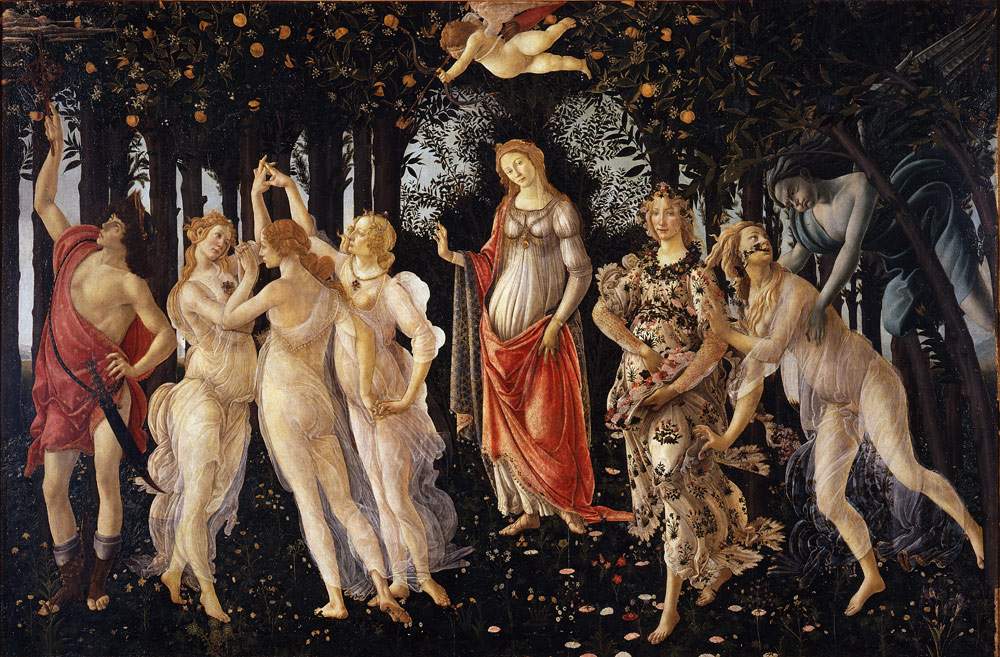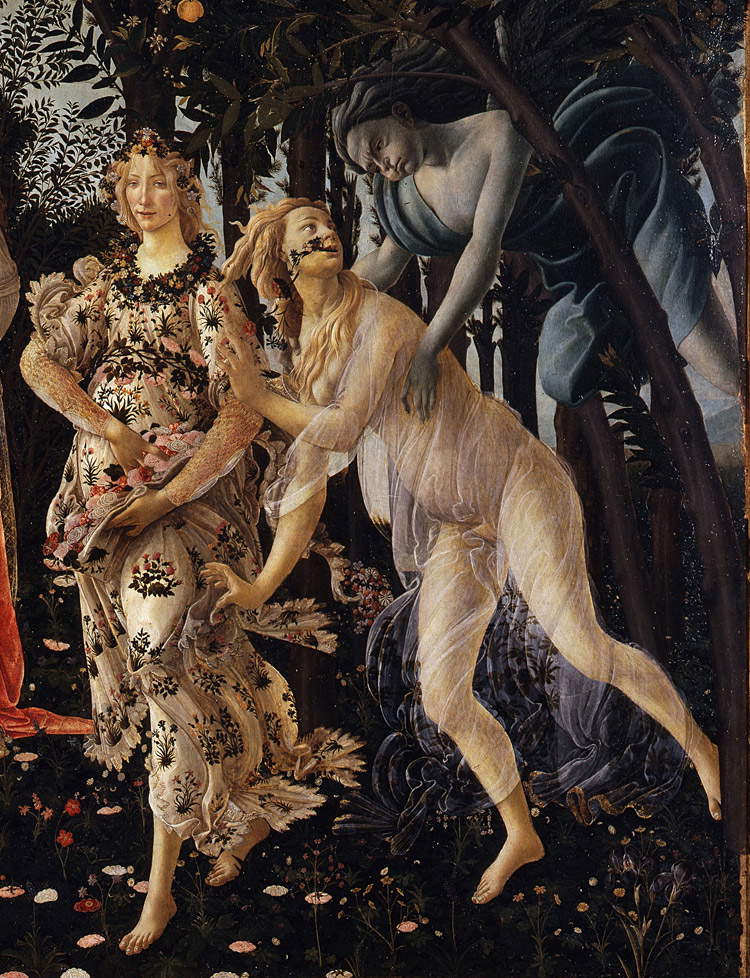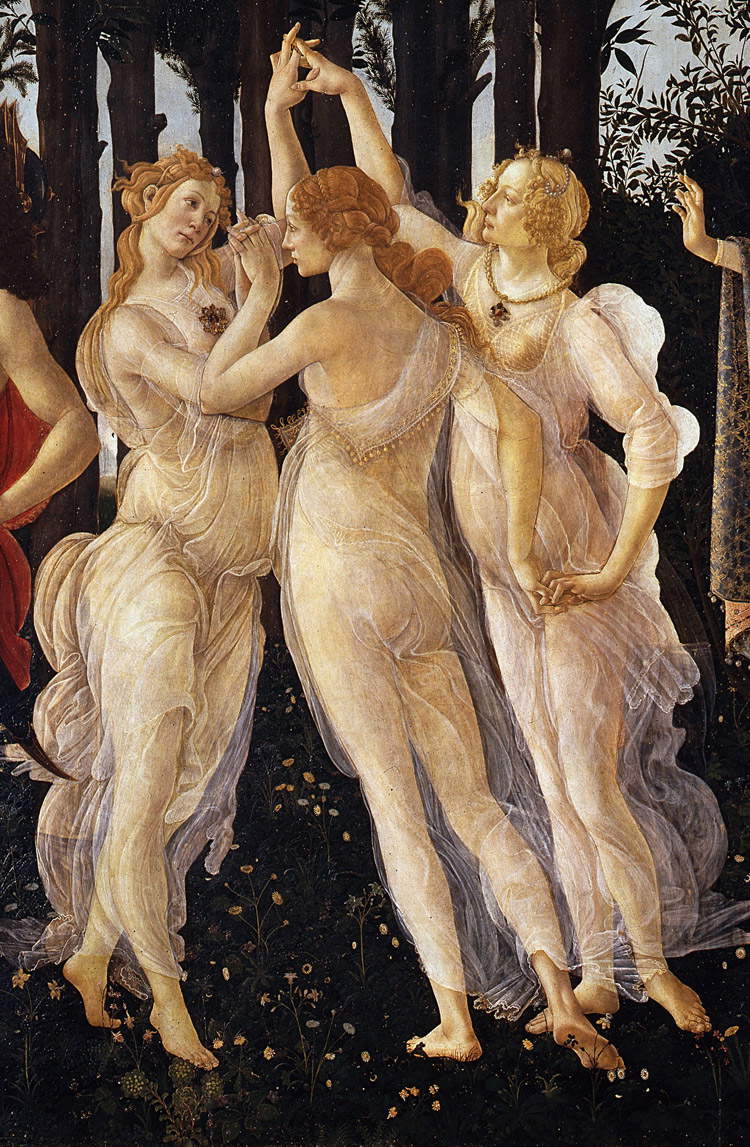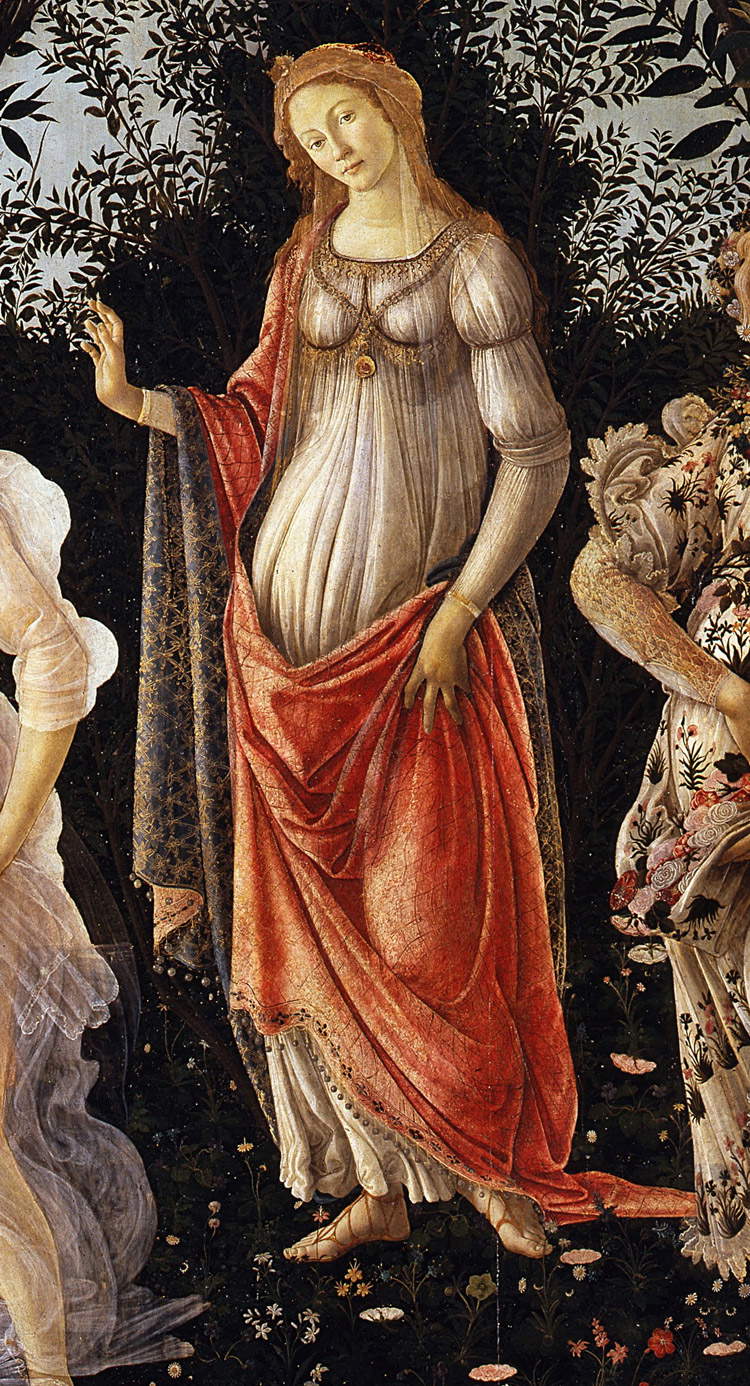What if the figure at the center of Botticelli's Primavera is not Venus?
La Primavera, the great masterpiece that Sandro Botticelli (Florence, 1445 - 1510) executed in the mid-1480s for Lorenzo di Pierfrancesco de’ Medici (Florence, 1463 - 1503) and which today is the absolute protagonist of the exhibition itinerary of the Uffizi Gallery in Florence, is certainly one of the most studied paintings in the entire history of art: from Giorgio Vasari onward, a great many art historians have grappled with the interpretation of the painting, arriving at conclusions that are often dissimilar and never definitively conclusive. Providing a list of all the positions is an operation that goes beyond the reasons of an article that was created for an online journal: however, it is possible to summarize the reading of the Spring that perhaps more than any other has imposed itself on critics and the public. This is the interpretation that Aby Warburg (Hamburg, 1866 - 1929) proposed in his doctoral thesis of 1891, later published in 1893 under the title Sandro Botticellis Geburt der Venus und Frühling: eine Untersuchung über die Vorstellungen von der Antike in den Italienischen Frührenaissance (in Italian it was published in various editions under the title La “Nascita di Venere” e la “Primavera” di Sandro Botticelli. Research on the Image of Antiquity in the Early Italian Renaissance).
Starting with the literary texts, and in particular Ovid ’s Fasti and Poliziano’s Stanze, Warburg suggested identifying in the two figures on the far right the wind Zephyrus and the nymph Clori, who later became, as a result of their union, Flora spreading flowers on the meadow. For the figure in the center, Warburg did not question the description of Giorgio Vasari, who spoke of a “Venus who graces her blooming, dinotating spring.” Above her is Cupid shooting an arrow, flanked by the three graces, and finally, closing the composition, the god Mercury, whom, according to the German scholar, Botticelli had depicted in the act of dispersing clouds. For Warburg, Primavera and Botticelli’s other famous masterpiece, the Birth of Venus, were complementary paintings: the Birth described the moment when the goddess of beauty and love came into the world by emerging from the waters and arriving on the shores of the island of Cyprus, while the Primavera presented her as she made her appearance in what the scholar, echoing Poliziano’s verses (“Ma fatta Amor la sua bella vendetta / Mossesi lieto pel negro aere a volo; / And ginne to his mother’s realm in haste / Ov’è de’ picciol suo’ frati lo stuolo / A regno ove ogni Grazia si diletta, / Ove beltà di fiori al crin fra brolo, / Ove tutto lasciviivo drieto a Flora / Zefiro vola e la verde erba infiora”), called the “realm of Venus.” The earth, as Venus passed, flourished and showed itself in all its splendor.
 |
| Sandro Botticelli, Primavera (c. 1482; tempera on panel, 207 x 319 cm; Florence, Uffizi Gallery) |
This reading, as anticipated, has remained essentially unchanged in substance through the decades and has guided subsequent critical positions. However, there are also those who have wished to depart from this interpretation. The latest contribution on the issue, an essay published in 2015 in the journal Il Capitale culturale, signed by art historian Giacomo Montanari of the University of Genoa and entitled Il Giardino delle Esperidi. Botticelli’s Primavera reread according to Ovid (can be read in full from the journal’s website). The scholar started from an observation: in interpreting the figures of Zephyrus, Chloris, Flora and the Graces, all scholars, from Warburg onward, have slavishly followed Ovid’s Fasti, while opting for other sources in order to identify the remaining characters. Could it be that Botticelli drew from multiple literary sources in order to create a kind of mosaic of references? The answer, for Giacomo Montanari, can only be negative: more likely, if anything, that Botticelli had relied on a single literary text, myth or philosophical concept, by reason of the fact that the artist, the scholar explains, was familiar with the works of Dante Alighieri (for whose interpretation he enlisted the help of the humanist Cristoforo Landino), and perhaps was aware of the four-way division of senses that a text can take on. According to Dante, who entrusts his own considerations on the subject to his Convivio, a text can be analyzed on the literal, the allegorical, the moral and the anagogical level: for Dante, each sense was built on the basis of the preceding one, which is why the interpretation of a text becomes clear only if all the senses have been understood, especially the literal one, since “in each thing, natural and artificial, it is impossible to proceed, if first the foundation is not made, sì come ne la casa e sì come ne lo studiare: Whereby, whether it be what the proving be edification of science, and the literal proving be foundation of the others, especially of the lallegorical, it is impossible to the others to come before that.” It would therefore be necessary to find a reading that satisfies all four senses.
Thus, in order to come closer to a clearer understanding of Botticelli’s painting, it is possible to abandon the assumption that the painter turned to multiple sources, and continue in the reading of Ovid’s Fasti where exegetes of Botticelli’s work have paused to accommodate additional sources. The narrative of Zephyrus who seizes Clori and then decides to marry her, making her Flora, the goddess of spring who makes the meadows bloom over which come the “Graces who weave garlands so that their heavenly locks may be adorned with silks,” continues with Flora’s first-person narrative of how her intervention was decisive in bringing the god Mars into existence. “Mars, too,” Flora says in the Ovidian poem, “if you do not know, was born by my art”: Juno had in fact been angry with Jupiter because the latter had given birth to Minerva without need of her, a reason that prompted her to ask herself “why must I despair of becoming a mother without a spouse? And why can I too, though chaste, not have offspring without a man?” Jupiter’s wife therefore sought help from Flora, who touched her womb, making her pregnant with Mars by this simple gesture. It is therefore entirely likely that Botticelli, following Ovid’s account, wanted to depict, in the center of his Primavera, the goddess Juno pregnant with Mars (and visibly pregnant, after all, the goddess appears in the painting). The Genoese scholar has thus responded to a cue from Mirella Levi d’Ancona, who noted how the myth of the birth of Mars was absent from the painting, also important for a city like Florence, which attributed its mythological foundation to the god Mars himself, and which believed, during the Renaissance, that the Baptistery rose on the site of an ancient temple dedicated to the god. A god who, moreover, in the Latin tradition had warlike connotations, but without the excesses of the Greek Ares: the Latin Mars, to whom the month of March was consecrated, was also a god linked to the earth, defender of crops. After all, the humanistic culture of the time nurtured a very strong interest in ancient mythology and civilization, whose teachings were considered still relevant today and which, wrote Paul Oskar Kristeller, was considered by the humanists “as the main guide and model, in literature as in thought,” with the result that every humanistic work was “littered with quotations from Greek and Latin authors, episodes from classical mythology, ideas and theories derived from ancient writers and philosophers.” It therefore makes sense that a painting, intended for a member of the family that de facto ruled the fortunes of Florence, would also imply a recovery of the city’s origins.
 |
| The Zefiro - Clori - Flora group |
 |
| The Three Graces |
 |
| Venus/Juno |
There would then subsist, according to Montanari, a further reason to unhinge the traditional hypothesis that sees the goddess Venus in the central figure of Sandro Botticelli’s painting, in favor of her identification with Juno. In fact, the orange trees that frame the scene recall the gift that, according to Greek mythology, Hera (i.e., Juno) had received on the occasion of her marriage to Zeus (Jupiter): an orange tree, in fact (and it should also be considered that the Latin name by which the orange tree was designated in ancient times, citrus medica, had caused the plant to become a Medici symbol). The setting of the painting would therefore coincide with the Garden of the Hesperides, the mythological garden where Hera had planted the tree given to her as a gift, and which was guarded by the Hesperides, the nymphs whose task was to prevent the fruits of the precious plant from being plucked.
That would leave two problems to be solved: the figures of Mercury and Cupid. For the latter, it is quickly said: without love, life cannot be generated, so his presence, as the god of love, is necessary for Juno to give birth. But that is not all: love, according to the neo-Platonic philosophy that animated the Florentine culture of the time, is the feeling that, moving from beauty, elevates human beings by making them tend toward divine contemplation. It is precisely the reference to neo-Platonic philosophy that allows us to understand the presence of Mercury, who appears in the painting with a black helmet instead of the traditional winged petasus: this would be thehelmet of Hades, whose association with the Greek Hermes (the Mercury of the Romans) is to be found in the Bibliotheca of Apollodorus (the god is said to have worn it in a battle). This is the same helmet to which mythology attributed the power to make invisible those who put it on their heads. Botticelli may therefore have inserted this detail to make the figure of Mercury “invisible,” whose presence is justified by neo-Platonic philosophy: in fact, Ficino believed that the link between the earthly world and the spiritual world was ensured by the so-called celestial mercury, an entity that contained a part of earthly nature and a part of spiritual nature. Botticelli’s Mercury would thus be the personification of the spirit that according to Ficino hovered over the world, and this interpretation of his figure would also be comforted by the flames (a spiritual symbol) that decorate his robe and that, contrary to what one would expect, are pointing downward, symbolizing such a “connection” between heaven and earth. This, then, is why Mercury would be “invisible”: because, of course, such is Marsilio Ficino’s spiritus mundi. Moreover, with Mercury “invisible,” the figure of Juno would occupy the exact center of the composition, restoring the symmetry of the figures.
References to Neoplatonic philosophy would also clarify the moral sense of the work (the literal one consists of the rendering in images of Ovid’s verses, the allegorical one is resolved by the representation of spring). All that remains is to untie the knot about the anagogical meaning of Botticelli’s Primavera. The recovery of pagan myths in humanistic culture remained linked to the Christian religion: “even though pagan mythology triumphed in the poetry and treatises of the time,” Kristeller specifies, “its meaning was not to replace the Christian religion and its set of images, but to complement it. In most cases it was merely a literary adornment sanctioned by ancient precedent. Where it had a more serious intent, its use was justified by allegory, whereby pagan stories were given a hidden meaning that went to confirm Christian truth.” For such reasons, Christian deities often assimilated traits typical of pagan deities. Consequently, the goddess Juno who, as a virgin, conceives Mars, is perfectly superimposable to the figure of Our Lady who, chaste, begets Jesus Christ. “It therefore comes almost immediately,” Montanari concludes, “to refer to the Christian dogma of Christ’s conception, which occurred through the intervention of the Holy Spirit without Mary knowing man,” with the result that the religious meaning of Spring alludes to the "divine will that, through the fire of the Holy Spirit (like the spiritus mundi, the life-giving substance of Christianity also has as its symbol a tongue of fire), descends into the world to bring there a renewal and recreate a humanity worthy of living again in the blessed realm of earthly Paradise." Thus ends a reading, that of Giacomo Montanari, which is fascinating, profound and fitting, and which can well be juxtaposed with all those that have accompanied the critical fortunes of one of the most praised, studied, celebrated, and at the same time least accessible works of art in human history.
Warning: the translation into English of the original Italian article was created using automatic tools. We undertake to review all articles, but we do not guarantee the total absence of inaccuracies in the translation due to the program. You can find the original by clicking on the ITA button. If you find any mistake,please contact us.



























